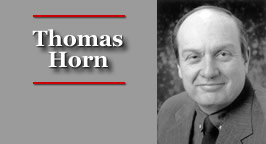Other
Horn
Articles:
Is God Trying To Talk To Somebody In America?
Giving Power to the Image of the Beast
Are Christians Being Groomed to Accept The Coming Antichrist?
By Thomas R. Horn
April
26, 2007
NewsWithViews.com
"Finally, brethren, whatsoever things are true, whatsoever things are honest, whatsoever things are just, whatsoever things are pure, whatsoever things are lovely, whatsoever things are of good report; if there be any virtue, and if there be any praise, think on these things" (Philippians 4:8).
Last Wednesday on the Fox News Channel, Evangelist Franklin Graham said Cho Seung-Hui, the killer at Virginia Tech University, was "filled with evil," and that Satan was responsible for the mass killings of 32 people at the V-Tech campus.
"There
is evil in the world, no question about it," Graham said. "I believe
Satan, the devil, is behind this  �
This young man was filled with evil. There's no way to describe the
fact that he could go and murder this many people and do what he did
without this man being possessed by an evil spirit who brought this
carnage on this university."
�
This young man was filled with evil. There's no way to describe the
fact that he could go and murder this many people and do what he did
without this man being possessed by an evil spirit who brought this
carnage on this university."
Graham's view is based on religious tradition that sees murderous intentions as inspired by the Devil, "a murderer from the beginning" (John 8:44).
Not everybody agrees on the origins of violent behavior, and strides in understanding human brain chemistry and genetics now have some neurologists hoping to eventually defuse violent behavior and to someday eliminate tragedies like the university massacre in Virginia.
Like Cho Seung-Hui, in March 2005, Jeffrey James Weise, a 17-year-old junior at Red Lake High School in Red Lake, Minn., went on a shooting spree that killed nine people and wounded 15 others at his school before killing himself. Also like Cho, he left an electronic trail across the Internet on websites such as nazi.org, calling himself "Angel of Death," expressing admiration for Adolf Hitler, and offering public insight into his fascination with dark imagery in the months and years before the shootings.
HAT COULD FILL A YOUNG PERSONS MIND WITH SUCH VIOLENT INTENT?
"There is no doubt in my mind that if we could have examined his brain (the killer at Virginia Tech) we would have found anomalies, and we would have been able to suggest for him to get therapies," said Dr. Allan Siegel, a neurologist and researcher at the University of Medicine of New Jersey (UMDNJ) in an AFP report this week.
"We might have been able to avoid this ... if he had been treated properly in the hospital setting."
Siegel told the AFP that clinical research as well as animal testing, particularly on cats, over some 40 years has shown that the front region of the brain, or the prefrontal cortex, including the limbic system, appears to play an important role in violent behavior.
Charles Whitman, who gunned down 16 people at the University of Texas in the 1960s, was found to have a tumor in the temporal lobe in the region of the limbic system. In 1999, when defense attorneys argued that 17-year-old Kip Kinkel - who similarly entered his school on a shooting rampage in 1998 - should not spend the rest of his life in prison, it was because Kinkel reportedly "heard voices" telling him to commit murders. During sentencing hearings Dr. Richard J. Konkol pointed out that "holes" in what is normally a smooth surface of Kinkel's brain revealed conditions consistent with schizophrenia. When defense attorney Mark Sabitt asked if this would make a person "more susceptible to a psychotic episode," Konkol responded, "I think it would."
Kinkel pleaded guilty to four counts of murder and 26 counts of attempted murder in the May 1998 shooting rampage in Springfield, Oregon. Kinkel's parents and two students at Thurston High School died as a result of the attack. 25 other students were wounded.
"My dad was sitting at the (breakfast) bar," said Kinkel, "The voices said, 'Shoot him.' I had no choice. The voices said I had no choice." Kinkel testified that after he killed his parents he was instructed by the voices to "Go to school and kill everybody."
Murderous voices first began speaking to Kinkel at age 12 when he got off the school bus and was looking at a bush. It said, "You need to kill everyone, everyone in the world." Kinkel believes the voices came from the devil, a satellite, or from a computer chip implanted in his head by the government.
Like Kinkel, Cho Seung-Hui felt compelled to shed the blood of innocent people this week, and then to kill himself. How could such ideas enter the mind of a young boy? Notorious "Son of Sam" killer David Berkowitz claims "bloodthirsty voices" commanded him to kill. According to Berkowitz, a convert of Christianity, a 6,000-year-old demon named Sam communicated through his neighbor's black Labrador retriever instructing him to carry out the murders. Berkowitz was subsequently diagnosed as having paranoid schizophrenia, a disease in which the person often hears pejorative or threatening voices separate from their own. Both Kinkel and Berkowitz were known to read pornographic and violent depictures of torture and murder. It appears from the initial evidence that Cho enjoyed the ponderings of mass murderers as well.
MURDER'S VOICE IN HISTORY
Schizophrenia is an accepted diagnosis of mental disorder and one cannot underestimate the positive contribution of such science. Yet for many devout persons like Franklin Graham and Christian psychologist James Dobson, the causes of violence in people suffering physical and mental illness, the appetite for disturbing images, and possible conditions such as schizophrenia, should be approached scientifically and spiritually during diagnosis and treatment. This presupposes a psychological influence of supernatural evil in some cases, and applies a literal interpretation to the words in the Bible that a Satanic influence affects the mind that rejects the voice of God and fills it with "envy, murder, strife, deceit and malice" (Romans 1:29).
Early cultures often interpreted such difficult psychological expressions through metaphysics. In Greece, Dionysus was the intoxicating god of unbridled human passion. He was the presence that is otherwise defined as the craving within man that longs to "let itself go" and to "give itself over" to evil human desires. What a Christian might resist as the evil thoughts of the carnal man, the followers of Dionysus embraced as the incarnate power that would, in the next life, liberate mankind from the constraints of this present world, and from the customs which sought to define respectability through a person's obedience to moral law.
Until then, worshippers of Dionysus attempted to bring themselves into union with their god through ritual casting off of the bonds of sexual denial and primal constraint by seeking to attain a higher state of ecstasy. The uninhibited rituals of ecstasy (Greek for "outside the body") supposedly brought the followers of Dionysus into a supernatural condition that enabled them to escape the temporary limitations of the body and mind, and to achieve a state of enthousiasmos, or, "outside the body and inside the god." In this sense Dionysus represented a dichotomy within the Greek religion, as the primary maxim of the Greek culture was one of moderation, or, "nothing too extreme." But Dionysus embodied the absolute extreme in that he sought to inflame the forbidden passions and murderous thoughts of the human mind. Interestingly, as most students of psychology will understand, this gave Dionysus a stronger allure among many Greeks who otherwise tried in so many ways to suppress and control the wild and secret lusts of the human mind.
But Dionysus resisted every such effort, and, according to myth, visited a terrible madness upon those who tried to deny him his free expression. The Dionystic idea of mental disease resulting from the suppression of secret inner desires, especially aberrant sexual desires, was later reflected in the atheistic teachings of Sigmund Freud. Thus, Freudianism might be called the grandchild of the cult of Dionysus.
Conversely, the person who gave himself over to the will of Dionysus was rewarded with unlimited psychological and physical delights. Such mythical systems of mental punishments and physical rewards based on resistance and/or submission to Dionysus, were both symbolically and literally illustrated in the cult rituals of the Bacchae (the female participants of the Dionystic mysteries), as the Bacchae women migrated in frenzied hillside groups, dressed transvestite in fawn skins and accompanied by screaming, music, dancing, blood letting, and licentious behavior. When, for instance, a baby animal was too young and lacking in instinct to sense the danger and run away from the revelers, it was picked up and suckled by nursing mothers who participated in the hillside rituals. But when older animals sought to escape the marauding Bacchae, they were considered "resistant" to the will of Dionysus and were torn apart and eaten alive as a part of the fevered ritual.
Human participants were sometimes subjected to the same orgiastic cruelty, as the rule of the cult was "anything goes," including rape and other acts of interpersonal violence. Later versions of the ritual (Bacchanalia) expanded to include pedophilia and male revelers, and perversions of sexual behavior were often worse between men than they were between men and women. Any creature that dared to resist such perversion of Dionysus was subjected to sparagmos ("torn apart') and omophagia ("consumed raw"). In B.C. 410, Euripides wrote of the bloody rituals of the Bacchae in his famous play, The Bacchantes:
"Bacchantes [with] hands that bore no weapon of steel, attacked our cattle as they browsed. Then wouldst thou have seen Agave mastering some sleek lowing calf, while others rent the heifers limb from limb. Before thy eyes there would have been hurling of ribs and hoofs this way and that, and strips of flesh, all blood be-dabbled, dripped as they hung from the pine branches. Wild bulls, that glared but now with rage along their horns, found themselves tripped up, dragged down to earth by countless maidens hands."
Euripedes went on to describe how Pentheus, the King of Thebes, was torn apart and eaten alive by his own mother as, according to the play, she fell under the spell of Dionysus.
The tearing apart and eating alive of a sacrificial victim may refer to the earliest history of the murderous voice of Satan. An ancient and violent cult idea existing since the dawn of paganism stipulated that, by eating alive, or by drinking the blood, of an enemy or an animal, a person might somehow capture the essence or "soul-strength" of the victim. The earliest Norwegian huntsmen believed this, and they drank the blood of bears in an effort to capture their physical strength. East African Masai warriors also practiced omophagia, and they sought to gain the strength of the wild by drinking the blood of lions. Human victims were treated this way by Arabs before Mohammed, and head-hunters of the East Indies practiced omophagia in an effort to capture the essence of their enemies.
Today, omophagia is practiced by certain Voodoo sects as well as by cult Satanists. Eating human flesh and drinking human blood as an attempt to "become one" with the devoured is, in many cases, a demonization of the Eucharist, or Holy Communion. But sparagmos and omophagia, as practiced by the followers of Dionysus, was not an attempt of transubstantiation (as in the Catholic Eucharist), nor of consubstantiation (as in the Lutheran communion), nor yet of a symbolic ordinance (as in the fundamentalist denomination), all of which have as a common goal--the elevating of the worshipper into a sacramental communion with God. The goal of the Bacchae was the opposite: The frenzied dance, the thunderous song, the licentious behavior, the murderous activity, all were efforts on the part of the Bacchae to capture the "voice" of the god (Dionysus) in order to bring him down into incarnated rage within man. The idea was not one of holy communion, but of possession by the spirit of Dionysus.
WHO'S BEHIND MURDER'S VOICE?
When one recalls the horrific rituals of the followers of Dionysus, it's easy to believe that demonic possession may have occurred. People of faith should find this idea plausible, as did the Hebrews who considered Hades (the Greek god of the underworld) to be equal with Hell and/or the Devil, and many ancient writers likewise saw no difference between Hades (in this sense the Devil) and Dionysus. Euripedes echoed this sentiment in the Hecuba, and refered to the followers of Dionysus as the "Bacchants of Hades." In Syracuse, Dionysus was known as Dionysus Morychos ("the dark one") a fiendish creature; roughly equivalent to the biblical Satan, who wore goatskins and dwelt in the reqions of the underworld.
In the scholarly book, Dionysus Myth And Cult, Walter F. Otto connected Dionysus with the prince of the underworld. He wrote: "The similarity and relationship which Dionysus has with the prince of the underworld (and this is revealed by a large number of comparisons) is not only confirmed by an authority of the first rank, but he says the two deities are actually the same. Heraclitus says, "Hades and Dionysus, for whom they go mad and rage, are one and the same."
Even the Hebrew prophet Ezekiel condemned the mind-altering madness of Dionysus as inherently satanic. He spoke of the "magic bands" (kesatot) of the Bacchae, which, as in the omophgia, were used to mesmerize the minds of men. We read, "Therefore, thus says the Lord GOD, Behold I am against your magic bands [kesatot] by which you hunt lives [minds/souls] there as birds, and I will tear them off your arms; and I will let them go, even those lives [minds/souls] whom you hunt as birds" (Ez. 13:20 NAS).
The kesatot, or "magic arm band," were used in connection with a container called the kiste. Wherever the kiste is inscribed on sarcophagi and on Bacchic scenes, it is depicted as a sacred vessel (a mind prison?) with a snake peering through an open lid. How the magic worked and in what way a mind was imprisoned is still a mystery. Pan, the half-man/half-goat god (later relegated to devildom) is sometimes pictured as kicking the lid open and letting the snake (mind?) out. Such loose snakes were then depicted as being enslaved around the limbs, and bound in the hair, of the Bacchae women.
The mysterious imagery of Pan, the serpents, the imprisoned minds, and the magic Kesatot and Kiste, have not been adequately explained by any available authority, and the interpretation of them as a method of mind control is subject to ongoing scrutiny. But since the prophet Ezekiel spoke of the efforts of the Bacchae to mystically imprison the minds of men through the magic bands of Dionysus, and since Pan was most beloved of Dionysus because of his pandemonium ("all the devils") which struck sudden panic in the hearts of men and beasts, and as the serpent was universally accepted by the Hebrews as a symbol of occult devotion, it can be surmised that the iconography of Dionysus represented the most tenacious effort on the part of the Bacchae to fulfill the psychological whims of evil supernaturalism.
SHUTTING MURDER'S MOUTH
In Acts 17:34 we read of the conversion of Dionysius the Areopagite. This is significant. Having the name Dionysius probably meant the parents were devotees of Dionysus, and thus the child was "predestined" to be a follower of the god. He may have also been under a mind-altering kesatot spell. Evidently the powers of darkness lost control over Dionysius's mind when he accepted the Gospel message. Jesus liberated him like He did the lunatics of Matthew 4:24 and 17:15. When Jesus touched the wild man, He left him "sitting, and clothed, and in his right mind" (Mark 5:15).
Contemporary stories of people whose minds were released from murderous madness through religious faith include David Berkowitz, the former Son of Sam killer. David accepted Christ on the prison floor. "When I finished talking to God, I got up. My mind seemed to flood with a sense of peace," said Berkowitz. "I knew from that moment that Jesus Christ heard me. I sensed in my heart that I was forgiven and that I was now free."
Ted Bundy pleaded for an interview with Dr. James Dobson prior to his court-ordered date with destiny. Bundy appeared genuinely sorrowful on videotaped interview and acknowledged the murderous effects of past sinful thinking. He asked Jesus to forgive him.
Karla Faye Tucker was the first woman executed in the state of Texas in 135 years. She testified of the mind-altering effect of drugs. On the eve of her execution, CBN reporter Kathy Chiero asked Karla, "Why do you agree to talk to the media regardless of why they are coming to you?" Karla responded, "God has given me a great big open door to share the love of Jesus and I'm going to do it. My heart has been to share with the world the love that he has poured out into me -- the forgiveness, the mercy, the way that he can change a life."
|
Subscribe to the NewsWithViews Daily News Alerts! |
Most of us view such deathbed conversions with skepticism. Last minute loyalties attributed to a Savior in the midnight hour can bring scoffing. Yet we read of the criminal on the cross and see Jesus honoring his plea for forgiveness. Jesus extended mercy, and offered him eternal fellowship.
Perhaps others will discover what David Berkowitz says he has -- saving power that is "mighty through God to the pulling down of strongholds; Casting down imaginations, and every high thing that exalteth itself against the knowledge of God, and bringing into captivity every thought to the obedience of Christ" (2 Corinthians 10:4-5).
Cho
Seung-Hui appears to have been lost from this idea.
� 2007 Thomas R. Horn - All Rights
Reserved
Thomas Horn is the CEO of RaidersNewsNetwork.com and SurvivorMall.com.
Over the last decade, he has authored three books, wrote dozens of published editorials, and had several feature magazine articles. In addition to past articles at NewsWithViews.com , his works have been referred to by writers of the LA Times Syndicate, MSNBC, Christianity Today, Coast to Coast, World Net Daily, White House Correspondents and dozens of newsmagazines and press agencies around the globe. Tom's latest book is "The Ahriman Gate," which fictionalizes the use of biotechnology to resurrect Biblical Nephilim.
Thomas is also a well known radio personality who has guest-hosted and appeared on dozens of radio and television shows over the last 30 years, including "The 700 Club" and "Coast to Coast AM." When looking for a spokesperson to promote their film "Deceived" staring Louis Gossett Jr. and Judd Nelson, "Cloud 10 Pictures" selected Thomas as their spokesperson to explain the Christian viewpoint on UFO-related demonology.
Web Site: RaidersNewsNetwork.com
E-Mail: RaidersNewsUpdate@gmail.com
Karla Faye Tucker was the first woman executed in the state of Texas in 135 years. She testified of the mind-altering effect of drugs.













